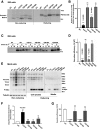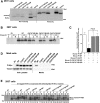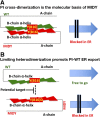Role of Proinsulin Self-Association in Mutant INS Gene-Induced Diabetes of Youth
- PMID: 32139596
- PMCID: PMC7171958
- DOI: 10.2337/db19-1106
Role of Proinsulin Self-Association in Mutant INS Gene-Induced Diabetes of Youth
Abstract
Abnormal interactions between misfolded mutant and wild-type (WT) proinsulin (PI) in the endoplasmic reticulum (ER) drive the molecular pathogenesis of mutant INS gene-induced diabetes of youth (MIDY). How these abnormal interactions are initiated remains unknown. Normally, PI-WT dimerizes in the ER. Here, we suggest that the normal PI-PI contact surface, involving the B-chain, contributes to dominant-negative effects of misfolded MIDY mutants. Specifically, we find that PI B-chain tyrosine-16 (Tyr-B16), which is a key residue in normal PI dimerization, helps confer dominant-negative behavior of MIDY mutant PI-C(A7)Y. Substitutions of Tyr-B16 with either Ala, Asp, or Pro in PI-C(A7)Y decrease the abnormal interactions between the MIDY mutant and PI-WT, rescuing PI-WT export, limiting ER stress, and increasing insulin production in β-cells and human islets. This study reveals the first evidence indicating that noncovalent PI-PI contact initiates dominant-negative behavior of misfolded PI, pointing to a novel therapeutic target to enhance PI-WT export and increase insulin production.
© 2020 by the American Diabetes Association.
Figures







Similar articles
-
Mutant INS-gene induced diabetes of youth: proinsulin cysteine residues impose dominant-negative inhibition on wild-type proinsulin transport.PLoS One. 2010 Oct 11;5(10):e13333. doi: 10.1371/journal.pone.0013333. PLoS One. 2010. PMID: 20948967 Free PMC article.
-
Biological behaviors of mutant proinsulin contribute to the phenotypic spectrum of diabetes associated with insulin gene mutations.Mol Cell Endocrinol. 2020 Dec 1;518:111025. doi: 10.1016/j.mce.2020.111025. Epub 2020 Sep 8. Mol Cell Endocrinol. 2020. PMID: 32916194 Free PMC article.
-
Endoplasmic reticulum oxidoreductin-1α (Ero1α) improves folding and secretion of mutant proinsulin and limits mutant proinsulin-induced endoplasmic reticulum stress.J Biol Chem. 2013 Oct 25;288(43):31010-8. doi: 10.1074/jbc.M113.510065. Epub 2013 Sep 10. J Biol Chem. 2013. PMID: 24022479 Free PMC article.
-
Proinsulin misfolding and diabetes: mutant INS gene-induced diabetes of youth.Trends Endocrinol Metab. 2010 Nov;21(11):652-9. doi: 10.1016/j.tem.2010.07.001. Epub 2010 Aug 18. Trends Endocrinol Metab. 2010. PMID: 20724178 Free PMC article. Review.
-
Misfolded proinsulin in the endoplasmic reticulum during development of beta cell failure in diabetes.Ann N Y Acad Sci. 2018 Apr;1418(1):5-19. doi: 10.1111/nyas.13531. Epub 2018 Jan 28. Ann N Y Acad Sci. 2018. PMID: 29377149 Free PMC article. Review.
Cited by
-
A Novel Nonsense INS Mutation Causes Inefficient Preproinsulin Translocation Into the Endoplasmic Reticulum.Front Endocrinol (Lausanne). 2022 Jan 5;12:774634. doi: 10.3389/fendo.2021.774634. eCollection 2021. Front Endocrinol (Lausanne). 2022. PMID: 35069438 Free PMC article.
-
Normal and defective pathways in biogenesis and maintenance of the insulin storage pool.J Clin Invest. 2021 Jan 19;131(2):e142240. doi: 10.1172/JCI142240. J Clin Invest. 2021. PMID: 33463547 Free PMC article. Review.
-
Pancreatic beta cell ER export in health and diabetes.Front Endocrinol (Lausanne). 2023 Apr 21;14:1155779. doi: 10.3389/fendo.2023.1155779. eCollection 2023. Front Endocrinol (Lausanne). 2023. PMID: 37152949 Free PMC article. Review.
-
Synthetic studies of the mutant proinsulin syndrome demonstrate correlation between folding efficiency and age of diabetes onset.Int J Pept Res Ther. 2025 Jan;31(1):11. doi: 10.1007/s10989-024-10665-z. Epub 2024 Nov 20. Int J Pept Res Ther. 2025. PMID: 39866851
-
Trapα deficiency impairs the early events of insulin biosynthesis and glucose homeostasis.J Clin Invest. 2025 May 20;135(14):e179845. doi: 10.1172/JCI179845. eCollection 2025 Jul 15. J Clin Invest. 2025. PMID: 40392602 Free PMC article.
References
-
- Edghill EL, Flanagan SE, Patch A-M, et al. .; Neonatal Diabetes International Collaborative Group . Insulin mutation screening in 1,044 patients with diabetes: mutations in the INS gene are a common cause of neonatal diabetes but a rare cause of diabetes diagnosed in childhood or adulthood. Diabetes 2008;57:1034–1042 - PMC - PubMed
Publication types
MeSH terms
Substances
Grants and funding
LinkOut - more resources
Full Text Sources
Medical
Research Materials
Miscellaneous

